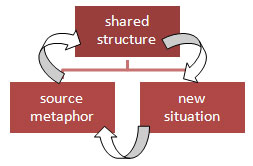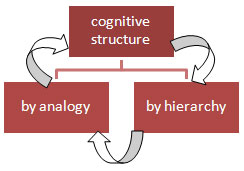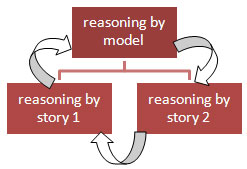| |
3.1 Metaphor/Analogy principles illustration
A few illustrated examples:
- Source metaphor => shared structure => new application situations.
- Philosophy: economics, biology
- Math: engineer, social science
- Cognitive structure: by analogical, by hierarchy
- Reasoning by model: reasoning by story 1, reasoning by story 2
- Template structure:source application, new application
- Learning science + communication + marketing: in family, in school, in workplace
1. Source metaphor => shared structure => new application situations.
 |
Relationships: 1. Shared structure is on the top level, and source metaphor and the new situation on the bottom level 2. When reasoning with a metaphor, we need to figure out the source metaphor, then abstract the shard structure, and finally apply this structure in the new situation. |
2. Philosophy: economics, biology
 |
Philosophy is the science of sciences. From the perspective of philosophy, any subject field is about three things: 1. The components of the field 2. The relationships between these components 3. For each components, repeat the operations of 1 & 2. |
3. Math: engineer, social science
 |
Math has been applied in engineer widely. How about social science? Can math be widely applied here? The answer depends on how we view math: math can be used to address well-structured data problems; moreover, math can also be used to build models for ill-structured and semi-structured. If we see math in this way, math should be able to inform social science greatly. |
4. Cognitive structure: by analogical, by hierarchy
 |
How knowledge is structured in our mind? When we learn something, which is the way of changing the structure? By hierarchy or by analogy? Can you make a guess according to your daily thinking and learning. |
5. Reasoning by model: reasoning by story 1, reasoning by story 2
 |
Experts reason by models; Just-plain-folks reason by stories. The models are usually created from stories. |
6. Template structure:source application, new application
 |
Step 1: create or find a source applicatiion Step 2: abstract the template structure Step 3: apply the template in a new application situation. |
7. Learning science + communication + marketing: in family, in school, in workplace
 |
These three subjects should --be taught explicitly and systematically from very young (maybe with the spiral curriculum) --be taught explicitly and embedded in learning any subjects UNFORTUNATELY, the reality is the inadequacy in every aspect. |
- Login to post comments
